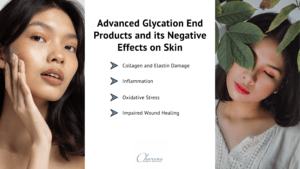The Sweet Culprit: Unravelling the Effects of Glycation on Skin Health
Introduction
In the pursuit of youthful and radiant skin, people often focus on external factors such as skincare routines, sun protection, and hydration. However, one often overlooked aspect that plays a significant role in skin aging is glycation. This biochemical process, triggered by the excess consumption of sugar, has far-reaching effects on the skin’s structure and appearance. In this blog post, we will delve into the intricacies of glycation and its profound impact on skin health.
Understanding Glycation
Glycation is a natural process that occurs when sugar molecules bind to proteins and lipids without the influence of enzymes. This non-enzymatic reaction results in the formation of advanced glycation end products (AGEs). The accumulation of AGEs in the skin can lead to various detrimental effects.
Effects of Glycation on Collagen
Collagen, the most abundant protein in the skin, is crucial for maintaining its firmness and elasticity. Glycation disrupts the structure of collagen, making it stiff and inflexible. This compromised collagen fails to provide the necessary support, resulting in sagging and wrinkles. The visible signs of aging, such as fine lines and loss of skin elasticity, can be attributed to the glycation-induced degradation of collagen.

Loss of Elasticity and Firmness
Glycation not only affects collagen but also impacts elastin, another protein responsible for skin elasticity. The cross-linking of elastin fibers caused by glycation reduces their flexibility, leading to a loss of skin elasticity. This process contributes to the formation of sagging skin and the appearance of wrinkles, making the skin look aged and tired.
Formation of AGEs and Oxidative Stress
The accumulation of AGEs in the skin triggers oxidative stress, a condition where there is an imbalance between free radicals and antioxidants. AGEs generate free radicals, which are highly reactive molecules that can damage cells, including skin cells. Oxidative stress accelerates the aging process, causing inflammation, uneven skin tone, and a dull complexion.
Hyperpigmentation and Uneven Skin Tone
Glycation can also lead to hyperpigmentation and an uneven skin tone. The interaction between sugar molecules and proteins can stimulate melanin production, the pigment responsible for skin color. As a result, areas of hyperpigmentation, such as dark spots and discoloration, may appear on the skin. This can further contribute to an aged and tired appearance.
Impact of Diet on Glycation
The primary source of glycation is the consumption of high-sugar diets. Processed foods, sugary snacks, and sweetened beverages contribute to elevated blood sugar levels, promoting the glycation process. Individuals with diets rich in refined carbohydrates and sugars may experience accelerated skin aging compared to those who prioritize a balanced and low-glycemic diet.
The CDC advises keeping added sugar intake, indicated on Nutrition Facts labels, to around 12 teaspoons daily—however, the typical adult actually consumes an average of 17 teaspoons per day.
Protecting the Skin from Glycation
While the glycation process is a natural part of aging, there are ways to minimize its impact and maintain healthier, more youthful-looking skin:
- Balanced Diet: Adopting a diet low in refined sugars and processed carbohydrates can help regulate blood sugar levels, reducing the potential for glycation.
- Antioxidant-rich Foods: Consuming foods rich in antioxidants, such as fruits and vegetables, can neutralize free radicals and mitigate the effects of oxidative stress.
- Hydration: Proper hydration supports overall skin health and can help flush out toxins, potentially reducing the accumulation of AGEs.
- Topical Antioxidants: Incorporating skincare products with antioxidants like vitamins C and E can provide additional protection against oxidative stress.
- Sun Protection: UV radiation can exacerbate the effects of glycation. Using sunscreen regularly helps prevent sun damage and supports skin health.
- Collagen-Boosting Ingredients: Skincare products containing ingredients like retinoids and peptides can stimulate collagen production and improve skin elasticity.
Conclusion
In the quest for ageless skin, understanding the impact of glycation is paramount.
A study says Prolonged exposure to sunlight can exacerbate glycation, a process in which sugars attach to proteins in the body. In fact, a study has shown that the damage caused by UV rays can contribute to a heightened accumulation of AGEs (Advanced Glycation End-products). By recognizing the link between sugar consumption and skin aging, individuals can make informed lifestyle choices to minimize the effects of glycation. A holistic approach, combining a balanced diet, proper skincare, and lifestyle modifications, can go a long way in preserving the skin’s youthful appearance and promoting overall skin health. Embracing these practices can empower individuals to age gracefully and maintain skin that radiates health and vitality.
To learn what enzymes are? How do they help my skin? Click here